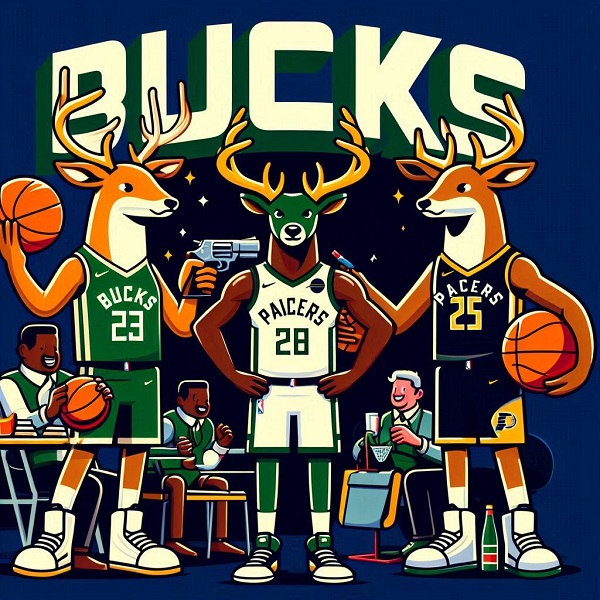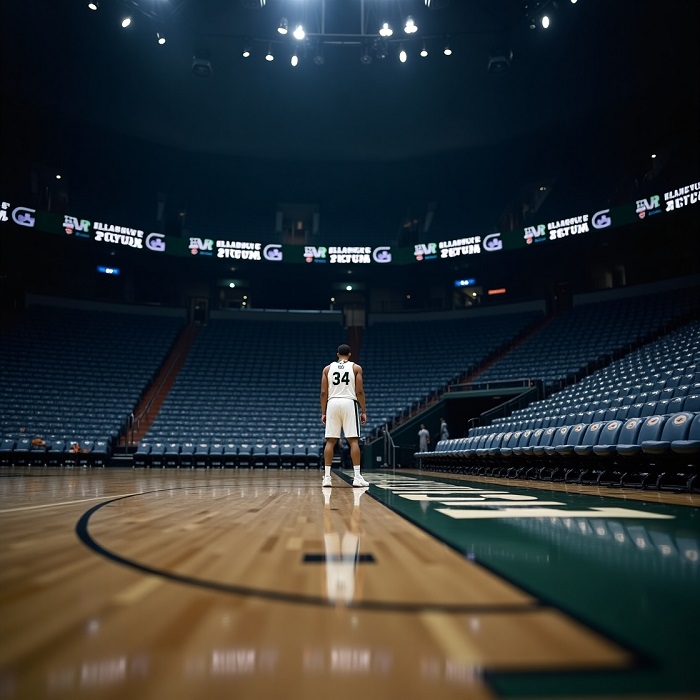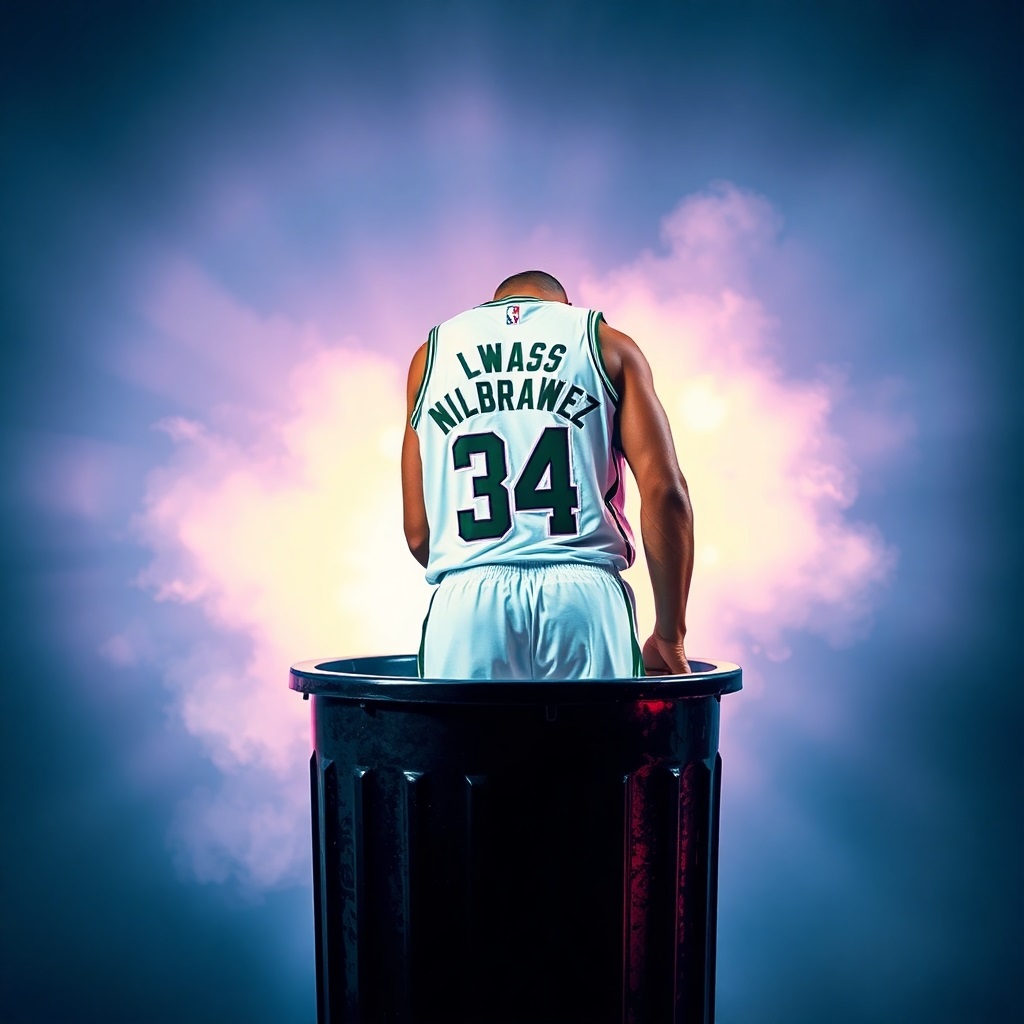The Milwaukee Bucks entered the 2025 NBA Playoffs as the No. 5 seed in the Eastern Conference, riding an eight-game winning streak and bolstered by the return of key players like Damian Lillard and Bobby Portis. Facing the No. 4 seed Indiana Pacers, who held home-court advantage for the first time since 2014, the Bucks were expected to leverage their star power and playoff experience to advance. However, the Pacers dispatched Milwaukee in a decisive 4-1 series, culminating in a thrilling 119-118 overtime victory in Game 5, driven by Tyrese Haliburton’s clutch heroics. Giannis’ fat statements about “NOW I know what I need to do” before the games proved to be just that: empty talk.
1. Defensive Struggles Against Indiana’s High-Octane Offense
The Pacers’ fast-paced, ball-movement-heavy offense overwhelmed Milwaukee’s defense throughout the series. Indiana, known for their relentless pace, averaged 17.5 fast-break points per game during the regular season, which jumped to 24.3 against the Bucks in their four regular-season matchups. This trend continued in the playoffs, where the Pacers exploited transition opportunities and defensive lapses to devastating effect.
Milwaukee’s defense, ranked in the bottom half of the league in points allowed per 100 possessions during the regular season, was ill-equipped to handle Indiana’s speed. In Game 2, for instance, the Bucks allowed 123 points, with critical breakdowns like Tyrese Haliburton blowing past Kyle Kuzma in transition and Pascal Siakam capitalizing on a 3-on-2 break. These plays highlighted Milwaukee’s inability to get back quickly enough to set their defense, a problem exacerbated by veterans like Brook Lopez and Damian Lillard, who appeared a step slow.
The Bucks’ defensive rating in the first two games was a dismal 121.8, reflecting their struggles to contain Indiana’s multi-faceted attack. The Pacers’ ability to create “power-play opportunities” (13.4% of their offensive possessions, second only to Denver) allowed players like Andrew Nembhard and Aaron Nesmith to exploit mismatches in transition. Milwaukee’s switch-heavy defensive strategy showed promise in Game 2’s fourth quarter, holding Indiana to 24 points, but inconsistent execution led to breakdowns, such as Siakam’s game-sealing 3-pointer in Game 2.
Giannis is clearly not the DPOY he once was. He is focusing on offence and is much slower and less energetic in defence. He roams looking for the highlight block thus confusing his team’s defensive plan. And of course they all have to clear out so he can rack up defensive rebounds for his stats – that’s an order. Contrast that to the selfless team play of Indiana and you see the problem. That stuff may work in regular season easier games but not in NBA playoffs. Giannis should know better and curtail his ego.
2. Inability to Contain Tyrese Haliburton’s Clutch Play
Tyrese Haliburton emerged as the series’ defining figure, particularly in Game 5, where his game-winning layup in overtime sealed the Bucks’ fate. Haliburton’s ability to deliver in high-pressure moments was a recurring nightmare for Milwaukee. In Game 3, he recorded 17 points, 8 rebounds, and 15 assists, leading Indiana to a 129-103 rout. His Game 5 performance, including a layup-and-one to cut a four-point deficit and a subsequent game-winner, underscored his knack for taking over games.
Milwaukee’s defensive schemes struggled to contain Haliburton, especially in pick-and-roll situations. The Pacers doubled ball screens involving Lillard, forcing him to make decisions under pressure, and Haliburton’s speed and playmaking exposed slower defenders like Lopez. In Game 2, Haliburton sprinted past Kuzma and drew Giannis away from his assignment, leading to open shots for teammates like Nesmith. The Bucks faced a tactical dilemma: leave Haliburton to score in the paint or risk open 3-pointers elsewhere, a question they failed to answer consistently. Giannis is just too slow to even understand what is going on, let alone adjust. Lateral speed has always been Giannis weak spot and it’s getting worse. In fact Giannis is worse this season at most statistical categories.
3. Offensive Inefficiencies and Poor 3-Point Shooting
Because of Giannis Antetokounmpo’s dominance the Bucks’ offence lacked rhythm and consistency. Milwaukee, the league’s best 3-point shooting team during the regular season at 38.7%, shot a dismal 24.3% (9 of 37) in Game 1. Coach Doc Rivers noted that many of these attempts came off late passes, disrupting the team’s offensive flow. Giannis always looks to get his easy bucket for his stats first. It’s predictable and all too often it leads to a (usually mediocre or even bad) pass with not much time left on the clock. Then everyone blames the receiver and not Giannis! The Bucks were the No1 team in the regular season for 3pt percentage.
The return of Damian Lillard, who missed Game 1 due to a blood clot but played 37 minutes in Game 2, didn’t provide the expected spark. Lillard, still recovering, shot 4-of-13 for 14 points in Game 2 and struggled defensively, likely due to his month-long absence and a calf injury. The Bucks’ reliance on Giannis to carry the offence was evident, but his lack of play making in Game 1 (one assist) highlighted the team’s struggle to generate open looks for shooters like Gary Trent Jr. and AJ Green. Giannis simply lacks the range of potential movements and the basketball IQ to understand how to change the team plays. Never in any universe should he be bringing down the ball.
4. Failure to Capitalize on Home Games
After falling into a 2-0 hole in Indianapolis, the Bucks had a chance to shift momentum at home in Games 3 and 4. They managed a 117-101 victory in Game 3, powered by Giannis (34 points) and Gary Trent Jr.’s hot shooting from deep. Here I had predicted the Pacers would let them win it way before the game and I was correct. The Pacers simply wanted to finish off the series in Indiana and make some extra money along the way. They responded with a commanding 129-103 win in Game 4, exposing Milwaukee’s inability to sustain defensive intensity. Indiana’s road performance was formidable, with an 18-9 record and the fourth-best road net rating after a slow start to the season. This resilience made it difficult for the Bucks to capitalise on home-court energy.
The Bucks’ Game 4 loss was particularly damaging, as Indiana’s balanced attack—led by six players in double figures—overpowered Milwaukee’s defense. The Pacers’ ability to maintain their high-octane offense away from home, averaging 117.8 points per 100 possessions on the road, meant the Bucks couldn’t rely on home advantage to slow Indiana down.
5. Historical Context and Rivalry Dynamics
The Pacers have historically had Milwaukee’s number in playoff match ups, never losing a series to the Bucks. In 2024, Indiana defeated a Giannis-less Bucks team 4-2, and this year’s 4-1 result continued that trend. The rivalry’s intensity, marked by incidents like the 2023 game-ball dispute and Haliburton’s “Dame Time” mimicry, added a psychological edge for Indiana. Haliburton himself acknowledged the animosity, stating, “We don’t like them, they don’t like us,” which seemed to fuel the Pacers’ focus.
The Bucks’ inability to channel this rivalry into consistent performance, especially after blowing a seven-point lead in the final minute of Game 5’s overtime, underscored their mental and tactical lapses, with Giannis bearing most of the blame but insisting on trying to guard Tyrese. He clearly couldn’t and it cost the game. Getting blown past once happens. Twice you are starting to look stupid. Three times in clutch and Giannis should have come out after the game and asked his team for forgiveness.
This was mainly Giannis’ fault
While Giannis delivered scoring outbursts—36 points in Game 1, 34 in Game 2, and 34 in Game 3—his shortcomings in play making, defensive discipline, and clutch situations were pivotal in the Bucks’ inability to compete effectively.
1. Limited Playmaking and Over-Reliance on Scoring
Giannis’s dominance as a scorer was evident, averaging 34.0 points per game on 56.2% field goal shooting, but his play making fell short of what the Bucks needed against Indiana’s high-octane offence. In Game 1, Giannis recorded just one assist, a stark contrast to Haliburton’s 15 assists in Game 3. His tendency to drive into crowded lanes and force shots, rather than facilitating for open teammates, disrupted Milwaukee’s offensive flow. The Bucks shot a dismal 24.3% from three in Game 1 (9 of 37), with many attempts coming off late passes or broken plays, a problem exacerbated by Giannis’s limited vision as a passer.

So this is interesting. Before these playoffs, the Pacers had many more assists per game than the Bucks. Yeah, we all know they pass a lot. So why then did they have LESS assists in every game of the playoff series against the Bucks?

This has Giannis written all over it. He simply can’t adjust and reverts to his selfish ways, running to dunk and then passing when he gets stuck. It is amazing his team mates get any in at all as they are usually stone cold and haven’t touched the ball for ages! The Pacers were all probing the paint quickly but then passing out immediately if they saw issues with the total team effort. There is no “i” in team but plenty of “I” in Giannis!
Indiana’s defensive strategy focused on clogging the paint, daring Giannis to kick out to shooters like Gary Trent Jr. or AJ Green. However, Giannis averaged only 3.8 assists per game in the series, compared to his regular-season average of 6.5. In Game 4, a 129-103 blowout loss, Giannis’s four turnovers, including two errant passes in the third quarter, led to fast-break points for the Pacers. His inability to consistently create for others allowed Indiana to collapse on him, stifling Milwaukee’s offence and leaving shooters like Damian Lillard, who was still recovering from injury, unable to find rhythm.
2. Defensive Lapses in Transition and Pick-and-Roll Coverage
The Pacers’ fast-paced attack, averaging 24.3 fast-break points per game in the series, exposed Giannis’s struggles in transition defence. His positioning and decision-making faltered against Indiana’s speed. In Game 2, Tyrese Haliburton blew past Kyle Kuzma in transition, drawing Giannis away from his assignment and leaving Aaron Nesmith open for a corner three. Similar breakdowns occurred in Game 5, where Giannis’s hesitation to pick up Haliburton in a 3-on-2 break led to a backbreaking layup. It seems like Giannis is more concerned with the optics and himself looking good than actually helping his team win.
In pick-and-roll situations, Giannis struggled to balance defending the ball-handler and protecting the rim. The Pacers’ use of double ball screens targeting Damian Lillard forced Giannis to hedge or switch, but he was often a step slow, allowing Haliburton to penetrate or find open teammates. Milwaukee’s defensive rating in the series was a poor 121.8 in the first two games, with Giannis’s inability to anchor the defence against Indiana’s “power-play opportunities” (13.4% of possessions) proving costly.
3. Clutch-Time Struggles and Poor Decision-Making
The Bucks’ collapse in Game 5’s overtime, blowing a seven-point lead in the final minute, highlighted Giannis’s struggles in clutch moments. With the game on the line, Giannis failed to take control, deferring to teammates or making questionable decisions. In the final possession of overtime, he drove into a crowded paint, ignoring an open Gary Trent Jr. on the wing, resulting in a blocked shot by Myles Turner. Haliburton capitalized on the other end with a game-winning layup-and-one, underscoring Giannis’s inability to deliver when it mattered most.
Giannis’s clutch-time stats were lacklustre: in the series’ five games, he shot 2-for-5 in clutch situations (last five minutes, score within five points) and committed two turnovers. His free-throw shooting, a long-standing weakness, also hurt the Bucks, as he went 10-for-16 (62.5%) in Game 5, missing key attempts that could have sealed the game in regulation. These misses shifted momentum to Indiana, who thrived on Milwaukee’s mistakes. This is nothing new. But Bucks’ fans have never admitted that in the championship run Khris bailed him out every time. Giannis simply can’t operate in clutch situations.
4. Failure to Lead and Elevate Teammates
As the Bucks’ leader, Giannis was expected to rally a roster dealing with injuries (Lillard’s calf issue and limited minutes in Game 2) and fatigue from heavy reliance on a seven-man rotation. However, his leadership on the court lacked the intangibles needed to counter Indiana’s intensity. The Pacers’ psychological edge, fueled by the ongoing rivalry and Haliburton’s taunting (mimicking “Dame Time” in Game 3), seemed to unsettle the Bucks. Giannis, despite acknowledging the rivalry’s intensity post-game, failed to channel it into cohesive team play. This has been his fault for many years now. From the game ball debacle in the regular season, Giannis has indeed acted like a child (to quote J.Brown!) and made the Pacers aware how easy it is to get him rattled.
In Game 3, the Bucks’ lone win (117-101), Giannis’s 34 points were complemented by Gary Trent Jr.’s hot shooting, but this was an outlier, as the Pacers probably didn’t really fight to win that game anyway. In losses, Giannis’s dominance didn’t translate to elevating players like Bobby Portis or Kevin Porter Jr., who struggled to find open looks. His tunnel vision in key moments, such as forcing drives against double-teams in Game 4, limited opportunities for role players to contribute, unlike Haliburton, who consistently set up teammates like Pascal Siakam and Andrew Nembhard. The higher the stakes, the worse Giannis plays. He tends to revert to his same, extremely predictable, go to moves and it simply doesn’t work.
5. Inability to Counter Indiana’s Strategic Adjustments
The Pacers made effective adjustments throughout the series, particularly in neutralising Giannis’s paint dominance. In Game 2, Indiana doubled Giannis on post touches, forcing him to pass out of tight spaces, which led to three turnovers in the third quarter alone. Coach Rick Carlisle’s strategy of using Myles Turner’s rim protection and Pascal Siakam’s versatility limited Giannis’s efficiency in the half-court, forcing him to rely on contested mid-range shots, where he went 3-for-10 in the series.
Giannis failed to adapt to these adjustments, and again it’s on Giannis who was sticking to his drive-heavy approach rather than exploiting Indiana’s smaller defenders, like Nembhard, with post-ups or quick passes. His lack of a reliable outside shot—0-for-3 from three in the series—allowed the Pacers to sag off him, clogging driving lanes and disrupting Milwaukee’s spacing. This predictability made it easier for Indiana to dictate the game’s tempo, especially in their 129-103 Game 4 rout.
The Milwaukee Bucks’ loss to the Indiana Pacers in the 2025 NBA Playoffs was a result of multiple compounding factors. Defensively, they couldn’t contain Indiana’s fast-break attack or Tyrese Haliburton’s clutch play making. For Milwaukee, this early exit raises questions about their defensive identity, roster construction, and ability to compete in a faster, more dynamic Eastern Conference. As the Bucks head into the off season, addressing these weaknesses will be critical to reclaiming their status as championship contenders. But take a minute before boasting how “every team wants to trade for Giannis” to think about it. Is he really any good at all at NBA playoff basketball or is he a liability?

If you want more detailed breakdowns:
Before the playoffs I analysed why Giannis struggles against the Pacers always.
Post game 1 analysis here
Giannis game 2 melt down here
How I knew the Pacers would throw game 3 here
The myth of Giannis’ mid range debunked after the playoffs again here
Game 5 Giannis masterclass of how to do everything wrong here









